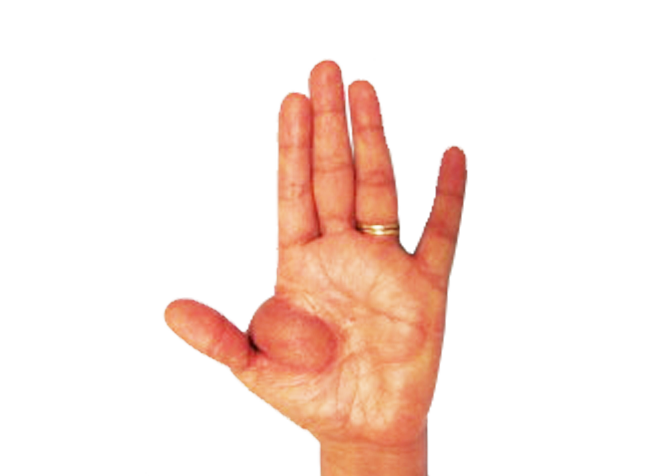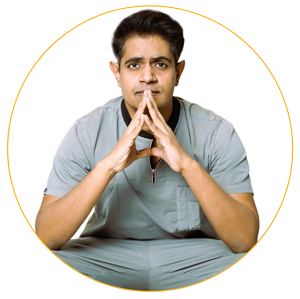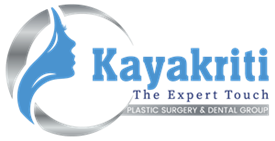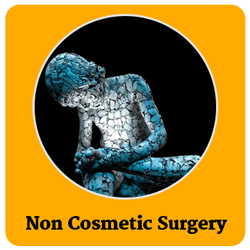Soft Tissue
Defects of Hand
Soft Tissue Defects of the hand are common with road traffic accidents, Industrial accidents, hand infections or other trauma.

Soft Tissue Defects of Hand of the hand are common with road traffic accidents, Industrial accidents, hand infections or other trauma. They can be on the Palmer aspect of the hand or on the dorsal aspect (backside of the hand). The characteristics of tissues on both the side of the hand are quite different from each other and this is kept in mind while planning the coverage of such defects. The basic aim ofcoverage of such defects is to give hand a proper shape and function.
Preoperative Management
- Patient is usually brought at emergency. Patient's vitals are taken and any other injury if present is examined and managed.
- Hand is thoroughly examined any fractures or infection is ruled out
- Wound is cleaned and irrigated thoroughly.
- Vascularity is assessed using capillary refill, pin prick and color of fingertips.
- Digital Xray of the finger/hand is done to rule out any bony injury.
- All pre operative investigations are done and the finger is immobilized.
Reconstructive Principles
- Irrigation
- Debridement
- Restoration of vascularity If there is no blood flow in the injured part. If the hand is brought amputated, reimplantation should be thought of.
- Stabilization of fractures-usually with a k wire or needle
- Repair of nerve and tendon if required
- Soft tissue cover if distal part is lost or damaged
Technique of reconstructions
Soft tissue reconstruction depends on size, shape, location and characteristics of the tissue lost. Efficient wound closure becomes a higher priority to prevent finger stiffness and maximize hand function.
Secondary healing (with only dressing and no sutures)
Only small wounds should be allowed to heal by re-epithelialization and closure may take 4-6 weeks. Healing by Secondary intention provides disadvantages of contour deformity, sensation loss and lack of donor site morbidity.
Skin grafting
Skin grafting is the transfer of thin skin sheet, usually taken from thigh, to cover the raw areas of the hand. Once the wound is healthy, skin grafting may be done if defect is not much deep and vitals structures are embedded in granulation tissue. In such cases, dressing is done every alternate day after surgery. Patient may be discharged after 5-6 days, and regular follow-up is required. The area gradually heals and need compression garment later to avoid hypertrophy of scars and to reduce the swelling.
Local flaps
Local flap is the transfer of flap of skin from the surrounding areas to the defect site. It is done when defect is deep and surrounding area is normal and sufficient enough to cover the defect. If not, or local flap fails, then a distant free flap is used to cover the defect through microvascular reconstruction. There are variety of options available to reconstruct THE HAND.
The reverse radial artery flap from the front of forearm and posterior interosseus artery flap from back of forearm are very versatile flap which can be used to resurface the hand in a very effective and efficient way with very less morbidity to the hand with the most natural result possible. It follows the principle of like replaces like and give hand the same skin which was there before the accident or trauma.
Flaps from Groin/Abdomen and chest-
Flaps from groin, abdomen and chestare very versatile flap which can resurface the hands. In this technique, the flaps from the groin, abdomen and chestare used to resurface the defect while remaining attached via skin pedicle. This is a 2 stage procedure. In the first stage, flap is harvested from the selected areaand the raw area is covered by Skin graft. In the second stage after 2-3 weeks when the flap has restored its blood supply over the defect, it is detached from the abdomen or chest. Some amount of cosmetic deformity of the grafted abdomen or chest(area of the harvested flap) should be acceptable to the patient.
Microvascular free flaps-
If defect is deep, any vital structures are visible, like blood vessels, nerve, bone or tendons exposed and no local tissue is available or patient does not want 2 stage procedure or any flap harvest from the abdomen groin and chest region, then transfer of skin flap, muscle flap from a distant area as a free flap is done to cover the defect using microsurgical techniques. It needs surgical expertise and a good working team. Dr Amit Agarwal specializes in microsurgical reconstruction and has saved innumerable hands from amputation. Flaps harvested from the outer aspect of the thigh, back and leg region are used commonly by Dr Amit Agarwal. He also harvests flap from the inner aspect of the foot (medial plantar artery flap) and transfer it to the palmer aspect of the defect to exactly match the kind of tissue loss.
The flap should be monitored frequently post-surgery. Hospital stay is increased, with respect to skin grafting or local flap procedures, but it is the best modality to cover the defects in patients who want a single stage procedure. Dressing is done every alternate day and patient is admitted for at least 7-8 days and discharged once the flap is settled
Post Operative Management
- Vascularity of flap is assessed for 48 hours
- IV antibiotics are given for 1 days
- Immobilization is done till sutures get mature
- Sutures are removed after 2 weeks
- Patient is discharged on 2th day
- Limb elevation is given
- If flaps from groin, abdomen and chest area are used then a second stage surgery is performed after 2 to 3 weeks. The patient is discharged next day after the first stage surgery and comes for the regular dressings and is readmitted again on the day of second stage surgery and is discharged on the same day.
- If microvascular surgery has been done for coverage of the defect of the hand, in the patient stays for around 7 to 10 days in the hospital for regular monitoring and medication
- Rehabilitation and physical therapy after 2 weeks with massage over the flap after 4 weeks.
Know your surgeon better

Best plastic surgeon, Dr. Amit Agarwal is an American Board Certified, extensively trained, and best Plastic & Aesthetic surgeon in Lucknow. He is the Chief Plastic Surgeon heading the Department of Plastic, Microvascular, and Craniofacial surgery at Vivekananda Polyclinic and Institute of Medical Sciences, Lucknow, U.P, India. He maintains a busy practice at Avadh and Nishat Hospital and his own center - Kayakriti Plastic Surgery & Dental Center. He was formerly a Consultant in the Department of Plastic Surgery and Burns at the prestigious SGPGI, Lucknow.
MS, DNB (General Surgery) MCh, DNB (Plastic Surgery),
MNAMS, FACS, FICS, FRCS (Edinburgh, UK)
His Credentials
Three pillars of kayakriti
Privacy
We believe your experience with us should be comfortable and hassle-free to make it one of your best lifetime experiences for yours. We, here at the clinic, take full precautions to maintain your privacy in any manner. We also provide a staff who will receive you from the gate and take you to the chamber directly if you demand.
Trust
Our Surgeon is highly qualified and internationally certified with a team of skilled staff to perform any surgical or non-surgical treatment on your body.
Safety
When you plan to undergo any surgery you should always keep in mind that it's your body and it's a surgery. We, here always keep your safety a priority and will never recommend you to undergo any such procedure which is not safe for you. We also provide you with a detailed description of the complications which may occur after the surgery during the consultation as it's a surgical procedure so there may be some complications depending on the way your body reacts.
Kayakriti in news



Frequently Asked Questions
If you have flat or small breast and you want to improve your breast and hip contour ratio then you are a good candidate for it. The answer will be best provided after the first consultation with Dr Amit Agarwal.
Acute pain will be there for almost a week which gradually reduces and there will be soreness and swelling which may take up to 3 weeks to subside.
You can join your work and daily routines after a week of the procedure and can start exercising after 3 weeks of it.
Yes, you have to wear it round the clock unless we suggest you to remove it.
This surgery does not affect the ducts or the areas of the breast involved in milk production. Thus, it does not affect the breast feeding.
This surgery does not affect the ducts or the areas of the breast involved in milk production. Thus, it does not affect the breast feeding.












Kayakriti Plastic Surgery & Dental Center
D-43, Near Punjab National Bank, Rajajipuram, Lucknow, Uttar Pradesh - 226017, India
Phone No. +919695940009, +919695940006
Map Location





























Social Media Presence